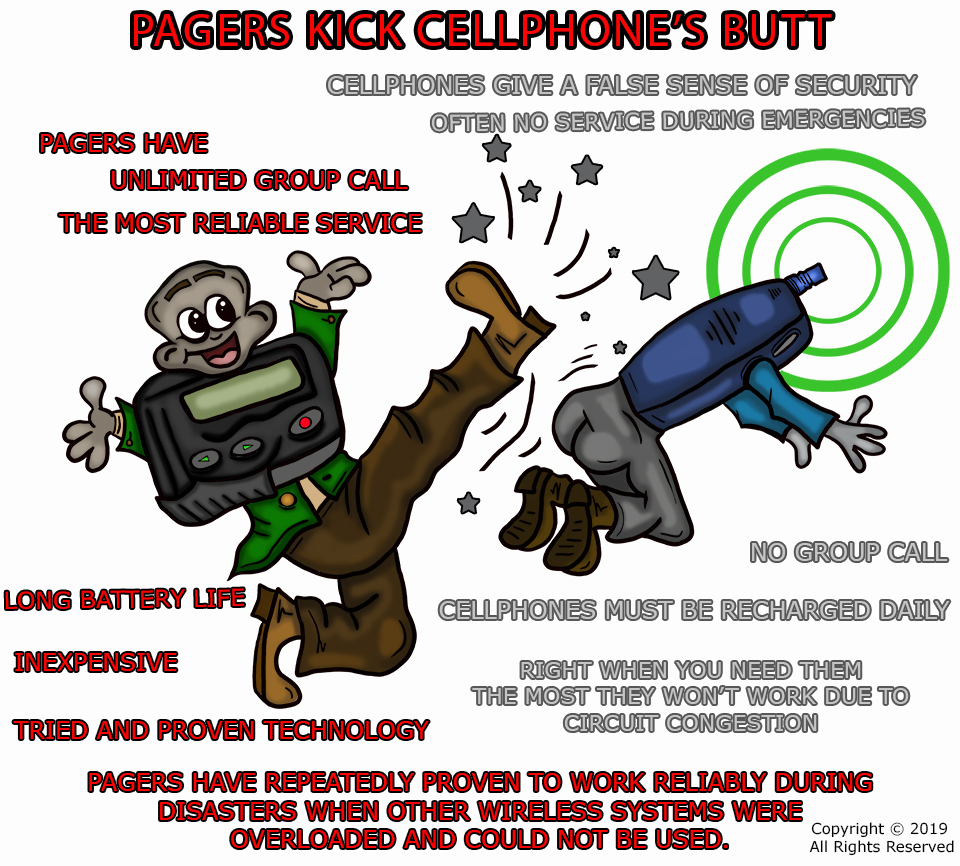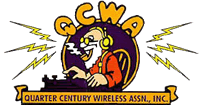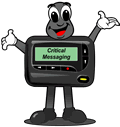

| Wireless News Aggregation |
|
Welcome Back ToThe Wireless
|
NO POLITICS HERE This doesn't mean that nothing is ever published here that mentions a US political party—it just means that the editorial policy of this newsletter is to remain neutral on all political issues. We don't take sides.
A new issue of the Wireless Messaging Newsletter is posted on the web each week. A notification goes out by e-mail to subscribers on most Fridays around noon central US time. The notification message has a link to the actual newsletter on the web. That way it doesn’t fill up your incoming e-mail account. There is no charge for subscription and there are no membership restrictions. Readers are a very select group of wireless industry professionals, and include the senior managers of many of the world’s major Paging and Wireless Messaging companies. There is an even mix of operations managers, marketing people, and engineers — so I try to include items of interest to all three groups. It’s all about staying up-to-date with business trends and technology. I regularly get readers’ comments, so this newsletter has become a community forum for the Paging, and Wireless Messaging communities. You are welcome to contribute your ideas and opinions. Unless otherwise requested, all correspondence addressed to me is subject to publication in the newsletter and on my web site. I am very careful to protect the anonymity of those who request it. I spend the whole week searching the Internet. for news that I think may be of interest to you — so you won’t have to. This newsletter is an aggregator — a service that aggregates news from other news sources. You can help our community by sharing any interesting news that you find.
Editorial Opinion pieces present only the opinions of the author. They do not necessarily reflect the views of any of advertisers or supporters. This newsletter is independent of any trade association. I don't intend to hurt anyone's feelings, but I do freely express my own opinions. We need your help. This is the only remaining news source dedicated to information about Paging and Wireless Messaging. |
 |
 |
Subscribe Here IT'S FREE * required field
|
 |
Advertiser Index
|
Service Monitors and Frequency Standards for Sale
(Images are typical units, not actual photos of items offered for sale here.)
|
| Leavitt Communications |
|
||||||||||||||||||||||||
|
|||||||||||||
Paging Transmitters 150/900 MHz The RFI High Performance Paging Transmitter is designed for use in campus, city, state and country-wide paging systems. Designed for use where reliable simulcast systems where RF signal overlap coverage is critical.
Built-in custom interface for Prism-IPX ipBSC Base Controller for remote control, management and alarm reporting.
Prism-IPX Systems LLC. 11175 Cicero Dr., Alpharetta, GA 30022
|
The Wireless Messaging News
The Board of Advisor members are people with whom I have developed a special rapport, and have met personally. They are not obligated to support the newsletter in any way, except with advice, and maybe an occasional letter to the editor.
Can You Help The Newsletter? You can help support The Wireless Messaging News by clicking on the PayPal Donate button above. It is not necessary to be a member of PayPal to use this service.
Newspapers generally cost A donation of $50.00 would certainly help cover a one-year period. If you are wiling and able, please click on the PayPal Donate button above. |
|||||||||||||||
A COMEDY OF ERRORS
I have a Mac Pro computer (late 2013 design). It is a really great machine, although a little out of date with today’s fast-paced-rate of computer evolution. Seems like a new state-of-the-art computer becomes obsolete in six months to one year. Fortunately, it is covered by Apple’s extended warranty. The first problem started with iMessage failing to send messages after an OS update. After several unsuccessful telephone sessions with Apple Support Advisors, and escalating the issue to Senior Advisors, we finally decided that the problem was probably being caused by the fact that the unit’s serial number strangely did not appear when clicking on “About This Mac” but it was on the label. Finally, it was decided that I needed to take it to the Apple store in St. Louis for service — a two-hour drive from my home. So off I went to the “Genius Bar” in the Galleria Mall where a genius programmed the serial number into where it belonged. Once back home I verified that the serial number fix worked but other problems surfaced. Apps in the dock would no longer run; they just opened as the “show in finder” command would normally do. That problem was fixed (I think) by the disconnection of all the USB peripherals and re-installing the Apple OS with the “combo” version. I’m not sure which one did the job. During all this confusion my dog got excited one day when the garbage truck came to pick up the trash and while running to look out of the window of my office, he got tangled up in one of my display cables and damaged the cable. Not knowing that some interconnect cables are “active” and some are “passive” I just ordered a regular cable and was pleased that the display in question worked just fine with the new cable. I assumed that all Thunderbolt to DVI-D cables were all active because I had disassembled the damaged one and saw that there was a lot of very small electronic components inside of the connector hood. You know what they say about “assume.” Based on my mistaken assumption about cables and Apple’s Advisors lack of knowledge; that is where things got really confusing. I had been using three displays, but now all of a sudden only two of the three would work. The third one was black. I even added a fourth display but the result was two on and two off. So back through the support system. Support Advisors skills are basically limited to 1) make sure your computer in plugged into AC power and 2) then to do a couple of resets. Friendly people all, but not highly competent technically. Step up to Senior Advisors and the technical knowledge is much better but even at this level of help we still couldn’t get the darn computer to light up more than two displays. All the specs say it will support six displays. So back to the Apple store in St. Louis, Got lucky with a lady-genius who had been there for a long time. Diagnostic testing revealed nothing so it was sent to the Apple repair center in Memphis. After several days the repair center they replaced almost all of my Mac Pro’s internal components and sent it back to me at home via FedEx. Great service! Except it came back with the same problem. Two displays on and two dark. I reported this to Apple Service and was told to take it back to the store in St. Louis. I said that wasn’t going to happen again and found that my only option beyond a Senior Advisor was to escalate the issue to engineering. So, we did that. Several days later engineering responded by referencing an online support article and telling me to read it very carefully and do exactly as is says. Of course, I had read it before but not carefully enough. My favorite—and the most competent Senior Advisor of the bunch—went over the article with me on the phone and explained that it was basically saying that the Mac Pro 2013 would only support two external displays using standard HDMI and/or DVI-D interconnect cables. To support more than two—up to six—it is necessary to use active adapters. Evidently the video signaling via HDMI and DVI-D is the same, only the connectors are different. It was confusing because it said that each port would need an active adapter with appropriate connectors and an additional USB plug for power. A USB splitter would also be needed to power all of the active adapters because the Mac Pro doesn’t have enough USB ports to do it. (Confusing, complicated and poorly written!) Turns out that there are actually three types of display interconnects available now-a-days:
Instead of the recommended-antiquated solution, I ordered four active interconnect cables that don’t need the extra USB port for power, e.g. thunderbolt 2 to HDMI and thunderbolt 2 to DVI-D. A lot of grief could have been spared with one simple sentence: “For more than two displays use active HDMI and/or DVI-D adapters.” Too bad none of the Apple support personnel knew this. There never was anything actually wrong with my computer. Anyway the mailman just brought my new active cables and all is well thanks to Quintin—the Apple senior advisor. P.S. I still love my computer. |
| Source: | Brad Dye | Don't miss the INSTRUCTIONAL VIDEO OF THE WEEK “Explaining Display Connectors” following below. |
|
Click on the image above for more info about advertising here. |
Internet. Protocol Terminal The IPT accepts Internet. or serial messaging using various protocols and can easily convert them to different protocols, or send them out as paging messages. An ideal platform for hospitals, on-site paging applications, or converting legacy systems to modern protocols.
Additional/Optional Features
Prism-IPX Systems LLC. 11175 Cicero Dr., Alpharetta, GA 30022 |
||||||||||||||||||||||||||||||
Paging Data Receiver PDR-4 The PDR-4 is a multi-function paging data receiver that decodes paging messages and outputs them via the serial port, USB or Ethernet connectors. Designed for use with Prism-IPX ECHO software Message Logging Software to receive messages and log the information for proof of transmission over the air, and if the data was error free.
Prism-IPX Systems LLC. 11175 Cicero Dr., Alpharetta, GA 30022 |
Wireless Network Planners
|
|||||||||||
Invitation
Let’s meet in spring in Florence. At CMAE20. 28th/29th April 2020This year the Spring Summit will take place in beautiful Florence on 28th and 29th April. Delicious wine, delicious pasta and vast hills in golden sunlight, through which, framed by cypresses, romantic old streets wind — welcome to Tuscany, welcome to Florence. The capital of Tuscany was once one of the richest and most prosperous metropolises in the world and, as the so-called cradle of the Renaissance, has decisively shaped our art and culture. Please reserve these dates in your diary. We will meet at Grand Hotel Adriatico, only a short foot walk away from the historical center of Florence with the cathedral, the Arno river and the famous bridge Ponte Veggio. Find reservation information in appendix B. Some points of the preliminary schedule of the event you can find in appendix A. It's all about Renaissance — including of more activity for critical messaging, of coming back to the wisdom that communications shouldn't be only broadband, but reliable, about the attractiveness of alternative communications, about getting more out than putting in, but . . . everybody should and can take part in intensive exchange of best methods. This invitation could make you a little bit excited about beautiful Florence and of course our Summit. Dietmar Gollnick Appendix A: Preliminary schedule
|
| Source: | e*Message Wireless Information Services Deutschland GmbH |
|
Remote AB Switches ABX-1 switches are often used at remote transmitter sites to convert from old, outdated and unsupported controllers to the new modern Prism-IPX ipBSC base station controllers. Remotely switch to new controllers with GUI commands. ABX-1 ABX-3 switches are widely used for enabling or disabling remote equipment and switching I/O connections between redundant messaging systems. ABX-3 Common Features:
Prism-IPX Systems LLC. 11175 Cicero Dr., Alpharetta, GA 30022 |
Radio enthusiasts worry about interference from LED streetlights
TOLEDO, Ohio (WTVG) — As the City of Toledo replaces its street lights with LEDs, some are wondering if the sound emitted from the devices will interfere with radio communications. "The Universe is full of noise," Mike Kehr, an instructor for amateur radio licensing, said. "When you turn the radio on and hear that it has sound and there's no signal there, that's the noise of the universe."
The noise that the amateur radio community is concerned about is LED lights. "The prices have come down enough that we can use them in applications like lighting our parking lots and our streets," says Kehr. However, Kehr says the lights make a lot of electrical radio noise and, "That noise can rise to the level of actual interference." So 13abc asked the city about the quality of the LED lights that are being installed. "These are the lights that Maumee is using right now, I believe Detroit as well," says Abby Arnold, the Deputy Chief of Staff for the City of Toledo. "These are General Electric lights. They are all well tested so they meet all the clearances. They're safe lights going in." 13abc also asked Toledo Edison about the LED lights that are being installed. A spokesman tells us they have had no problems reported so far in dozens of other cities where the same types of LED lights line the streets. |
Source: |
If LED streetlights interfere with two-way radios they will also interfere with pagers. Unfortunately people with digital pagers can't hear noise on the channel; they just miss messages because of the interference. With an analog, voice pager you can hear what's going on if it has an adjustable squelch. Either way you might miss an important message. I went with Ira Wiesenfeld once to visit one of his public safety customers where their pagers wouldn't receive messages in their main building. Ira located the cause of the problem in short order. He just flipped a switch and turned off all the florescent lighting. The high noise level that was blocking the pager reception was coming from solid-state ballasts in their new lighting system. A lesser man would have taken a couple of days to diagnose and resolve their problem and then charged them by the hour. |
| Leavitt Communications |
|
|||||||
Judge Blocks Huawei from Suing U.S.A U.S. District Court judge this week struck down a lawsuit from Huawei, ruling the telecommunications equipment firm didn't have the legal ground to sue the U.S. government. Huawei filed the lawsuit last year after Congress passed the National Defense Authorization Act. It prohibits federal agencies and contractors from purchasing certain products from Huawei and ZTE. In the complaint, Huawei claimed that the restrictions were overly punitive and singled out certain companies, reported The Hill. The Trump administration and congressional lawmakers have long had concerns over whether the Chinese government could use Huawei and ZTE to spy on the U.S. U.S. District Judge Amos Mazzant determined the U.S. wasn’t preventing Huawei from doing business in America, but rather, exercising its legal authority to control how federal money is spent. Huawei was disappointed in the ruling. “While we understand the paramount significance of national security, the approach taken by the U.S. government provides a false sense of protection while undermining Huawei’s constitutional rights,” a company official told Politico in a statement. “We will continue to consider further legal options,” the person added. |
| Source: | Inside Towers newsletter | Courtesy of the editor of Inside Towers Jim Fryer. Inside Towers is a daily newsletter by subscription. |
| BloostonLaw Newsletter |
Selected portions [sometimes more — sometimes less — sometimes the whole updates] of the BloostonLaw Telecom Update and/or the BloostonLaw Private Users Update — newsletters from the Law Offices of Blooston, Mordkofsky, Dickens, Duffy & Prendergast, LLP — are reproduced in this section of The Wireless Messaging News with kind permission from the firm. The firm's contact information is included at the end of this section of the newsletter.
Reminder: CPNI Certifications Due March 2Carriers should modify (as necessary) and complete their “Annual Certification of CPNI Compliance” for 2020. The certification must be filed with the FCC by March 2, because March 1 is a Sunday this year. Our clients can forward the original to BloostonLaw in time for the firm to make the filing with the FCC by March 1, if desired. BloostonLaw is prepared to help our clients meet this requirement, which we expect will be strictly enforced, by assisting with preparation of their certification filing; reviewing the filing to make sure that the required showings are made; filing the certification with the FCC, and obtaining a proof-of-filing copy for your records. Clients interested in obtaining BloostonLaw's CPNI compliance manual should contact the firm as soon as possible. Contacts: Gerry Duffy and Sal Taillefer. HeadlinesFCC To Release Mobility Fund Phase II Coverage Maps; Objections Due Feb. 27On February 12, the FCC issued a Public Notice proposing to release “certain mobile broadband coverage data” submitted pursuant to the 2017 MF-II Challenge Process Order. Parties that submitted MF-II coverage data have until February 27, 2020 to file objections. As we reported in a previous edition of the BloostonLaw Telecom Update, the MF-II Challenge Process Order required mobile broadband service providers to submit 4G LTE coverage data in a one-time data collection pursuant to specifications adopted for MF-II. In total, 48 mobile service providers filed the required data, with an additional five providers filing certifications that they did not provide 4G LTE service meeting the specifications of the data collection. FCC staff generated an initial map of areas presumptively eligible for MF-II support based upon an aggregation of these coverage data, and challengers had access to providers’ coverage data so that challengers could conduct speed tests of the networks of individual providers and submit data based upon those tests. Challengers were required to keep confidential the provider-specific mobile coverage data. The FCC is no proposing to release coverage maps showing the 4G LTE coverage of each of the 48 mobile service providers that filed data in response to the MF-II Challenge Process Order. According to the Public Notice, released coverage data would neither show a provider’s complete and current mobile broadband coverage nor reveal information on the spectrum bands that comprise its coverage meeting the MF-II specifications. The data to be released would not include link budget or clutter information. Parties that submitted MF-II coverage data have ten (10) business days from the date of the release of this Public Notice to object to the release of their own data. The deadline for filing such objections is February 27, 2020. Parties objecting must explain why publicly releasing these data will reveal information they have not already made available to the public and will harm them competitively, including a specific and detailed description of the extent of that harm. Carriers interested in filing objections should contact the firm for more information. BloostonLaw Contacts: John Prendergast, Cary Mitchell, and Sal Taillefer. FCC Authorizes Over $240 Million For Rural BroadbandOn February 13, the FCC authorized more than $240 million in funding over ten years to expand rural broadband deployment in Arkansas, Illinois, Indiana, Kansas, Massachusetts, Missouri, New York, Oklahoma, and Wyoming. These investments will connect more than 100,000 unserved rural homes and businesses in these states. Broadband providers will begin receiving funding later this month. “Today’s announcement is another important step in our efforts to close the digital divide and connect rural Americans with the economic, healthcare, and educational opportunities made possible by high-speed broadband,” said FCC Chairman Ajit Pai. “Earlier this week, I had the opportunity to see firsthand how funding provided through the FCC’s Connect America Fund Phase II auction is having a positive impact on the Wind River Indian Reservation in rural Wyoming. And the funding we are authorizing today will bring those same benefits and connect more rural Americans with digital opportunity.” This represents the ninth wave of support from the successful 2018 Connect America Fund Phase II auction. Providers must build out to 40% of the assigned homes and businesses in the areas won in a state within three years. Buildout must increase by 20% in each subsequent year, until complete buildout is reached at the end of the sixth year. A map of winning bids in the Auction is available at https://www.fcc.gov/reports-research/maps/caf2-auction903-results/. BloostonLaw Contact: Sal Taillefer Congress Seeks to Steer C-band Auction Proceeds to Meet Urgent NeedsA bipartisan effort in the U.S. Senate is seeking to change how the FCC will auction a portion of the C-band spectrum for 5G services later this year. The Spectrum Management and Reallocation for Taxpayers (SMART) Act (S. 3246), introduced in late January by Sens. John Kennedy (R-La.), Brian Schatz (D-Hawaii) and Maria Cantwell (D-Wash.) seeks to ensure that billions of dollars in proceeds from the public auction of C-band spectrum are used to bridge the digital divide, to enable next-generation public safety services and to reduce the national debt, rather than being used for windfall payments to satellite operators. The C-band (3.7-4.2 GHz) has been identified as key mid-band spectrum for deployment of 5G services. The band is now mostly used by fixed satellite companies to beam content to video and audio broadcasters, cable systems and other content distributors. A C-band proposal favored by FCC Chairman Ajit Pai and revealed earlier this month would provide satellite operators the opportunity to receive up to $9.7 billion in accelerated payments if they are able to clear the lower portion of the C-band on an accelerated timeline. The accelerated payments are separate from the relocation costs, which are expected to range from $3 billion to $5 billion. Under the draft rules, which are scheduled for Commission vote at the FCC open meeting on Feb. 28th, winning bidders in the C-band auction would be required to reimburse satellite operators for “reasonable” relocation costs. In contrast, the SMART Act legislation would allocate up to $5 billion from auction proceeds to reimburse the satellite companies for relocating, and provide no more than $1 billion of auction revenue for incentive payments to them. “The real winners here are the American taxpayers who not only own the C-Band, but stand to reap the benefits of 5G. Rather than bailing out foreign satellite companies, money from the auction of this spectrum should go to American priorities,” Senator Kennedy said in a press release. “This bill gives us the chance to pay down the national debt, improve public safety and get broadband to rural communities that are still handcuffed to dial-up Internet.” Chairman Pai explained the need for accelerated relocation payments in prepared remarks which said, “We want them to do that quickly in order to free up spectrum for 5G sooner rather than later. And this transition will be much faster if we can create powerful incentives for incumbent operators to expedite the transition. And to make sure they follow through—they would only be paid the full amount if in fact they did so.” Under Chairman Pai’s proposal, the auction of the lower portion of the C-band would start December 8th. BloostonLaw Contact: Cary Mitchell Law and RegulationComments on TRACED Act Implementation Due February 24On February 14, the FCC published in the Federal Register its Notice of Proposed Rulemaking proposing rules to implement the Pallone-Thune Telephone Robocall Abuse Criminal Enforcement and Deterrence Act (TRACED Act). Comments are due February 24, and reply comments are due March 2. As we reported in a previous edition of the BloostonLaw Telecom Update, the TRACED Act requires the FCC to establish a registration process for the registration of a single consortium that conducts private-led efforts to trace back the origin of suspected unlawful robocalls. Under the FCC’s proposal, the agency would issue an annual public notice seeking registration of a single consortium that conducts private-led efforts to trace back the origin of suspected unlawful robocalls. An entity that plans to register as the consortium for private-led traceback efforts would submit a letter of notice of its intent to conduct private-led traceback efforts and its intent to register as the single consortium. In the event that multiple entities register, the FCC would select the single registered consortium based on its analysis of any letter and associated documentation submitted by an entity seeking to register as the single consortium. While the FCC intends to continue to solicit interest by public notice on an annual basis, the incumbent consortium would not be required to file a new application each year. Rather, each certification in a letter will extend for the duration of each subsequent year that the incumbent consortium serves, unless the incumbent consortium notifies the FCC otherwise in writing on or before the date for the filing of such letters set forth in the annual public notice. BloostonLaw Contacts: Ben Dickens and Sal Taillefer. Senators Introduce Tribal Broadband BillOn February 14, U.S. Senator Tom Udall (D-N.M.), vice chairman of the Senate Committee on Indian Affairs, along with U.S. Senators Maria Cantwell (D-Wash.) and Martin Heinrich (D-N.M.) introduced the Bridging the Tribal Digital Divide Act of 2020 to accelerate the deployment of broadband services to Native communities and bridge the digital divide facing Native communities. According to a press release, the bill would expedite the deployment of affordable broadband service on Tribal lands by coordinating and improving the effectiveness of federal resources. Specifically, the Bridging the Tribal Digital Divide Act of 2020 will:
“Reliable Internet. access is fundamental to economic success in the twenty-first century,” Udall said. “It is unacceptable that Americans living on Tribal lands, in addition to Tribal governments, face so many barriers to accessing reliable broadband. Our legislation focuses on connecting Tribal communities with broadband funding and eliminating bureaucratic hurdles so that we can bridge this Tribal digital divide. This is fundamental to the effort to ensure that the federal government is upholding its trust and treaty responsibility to Native communities.” BloostonLaw Contacts: Ben Dickens, John Prendergast, and Sal Taillefer. IndustryFCC Announces Members of the Advisory Committee on Diversity and Digital EmpowermentFederal Communications Commission Chairman Ajit Pai today announced the appointment of members to serve on three working groups of the Advisory Committee on Diversity and Digital Empowerment (ACDDE). These working groups—Access to Capital, Digital Empowerment and Inclusion, and Diversity in the Tech Sector—will assist the ACDDE in carrying out its work. As previously announced, Chairman Pai designated Anna M. Gomez, Partner, Wiley Rein LLP, representing the Hispanic National Bar Association, to serve as Chair of the ACDDE, and Heather Gate, Director, Digital Inclusion, Connected Nation, to serve as Vice Chair. Since Chairman Pai first announced the members of the ACDDE, he has appointed several new working group members, including Milton Clipper, Founder, Clipper and Company, representing America’s Public Television Stations; Rosa Mendoza Dávila, Founder, President & CEO, ALLvanza; Garret Komjathy, Senior Vice President, Media & Communications Division, US Bank; Aama Nahuja, Legal Counsel, A Wonder Media Company, LLC; Felicia West, Policy Advisor, Public Service Commission of the District of Columbia; and Dr. Fallon Wilson, Executive Director, Black Tech Mecca. Other members include representatives from Verizon, T-Mobile and DISH. There does not appear to be any rural service provider representation at this time. The ACDDE is organized and operates in accordance with the provisions of the Federal Advisory Committee Act. ACDDE’s mission is to provide recommendations to the FCC on how to empower disadvantaged communities and accelerate the entry of small businesses, including those owned by women and minorities, into the media, digital news and information, and audio and video programming industries, including as owners, suppliers, and employees. In addition, the ACDDE will provide recommendations regarding how to ensure that disadvantaged communities are not denied the wide range of opportunities made possible by next-generation networks. More information about the ACDDE is available at https://www.fcc.gov/advisory-committee-diversity-and-digital-enpowerment. BloostonLaw Contact: John Prendergast DeadlinesMARCH 2: COPYRIGHT STATEMENT OF ACCOUNT FORM FOR CABLE COMPANIES. This form, plus royalty payment for the second half of calendar year 2019, is due March 1. The form covers the period July 1 to December 31, 2019, and is due to be mailed directly to cable TV operators by the Library of Congress’ Copyright Office. Because March 1 is a Sunday this year, this filing is due March 2. If you do not receive the form, please contact the firm. BloostonLaw Contact: Gerry Duffy. MARCH 2: CPNI ANNUAL CERTIFICATION. Carriers should modify (as necessary) and complete their “Annual Certification of CPNI Compliance” for 2020. The certification must be filed with the FCC by March 2, because March 1 is a Sunday this year. Note that the annual certification should include the following three required Exhibits: (a) a detailed Statement Explaining How The Company’s Operating Procedures Ensure Compliance With The FCC’S CPNI Rules to reflect the Company’s policies and information; (b) a Statement of Actions Taken Against Data Brokers; and (c) a Summary of Customer Complaints Regarding Unauthorized Release of CPNI. A company officer with personal knowledge that the company has established operating procedures adequate to ensure compliance with the rules must execute the Certification, place a copy of the Certification and accompanying Exhibits in the Company’s CPNI Compliance Records, and file the certification with the FCC in the correct fashion. Our clients can forward the original to BloostonLaw in time for the firm to make the filing with the FCC by March 1, if desired. BloostonLaw is prepared to help our clients meet this requirement, which we expect will be strictly enforced, by assisting with preparation of their certification filing; reviewing the filing to make sure that the required showings are made; filing the certification with the FCC, and obtaining a proof-of-filing copy for your records. Clients interested in obtaining BloostonLaw's CPNI compliance manual should contact the firm. BloostonLaw Contact: Gerry Duffy MARCH 2: FCC FORM 477, LOCAL COMPETITION & BROADBAND REPORTING FORM. This annual form is due March 1 and September 1 annually. The FCC requires facilities-based wired, terrestrial fixed wireless, and satellite broadband service providers to report on FCC Form 477 the number of broadband subscribers they have in each census tract they serve. The Census Bureau changed the boundaries of some census tracts as part of the 2010 Census. Because March 1 is a Sunday this year, this filing is due March 2. Specifically, three types of entities must file this form:
BloostonLaw contacts: Ben Dickens and Gerry Duffy. APRIL 1: FCC FORM 499-A, TELECOMMUNICATIONS REPORTING WORKSHEET. This form must be filed by all contributors to the Universal Service Fund (USF) sup-port mechanisms, the Telecommunications Relay Service (TRS) Fund, the cost recovery mechanism for the North American Numbering Plan Administration (NANPA), and the shared costs of local number portability (LNP). Contributors include every telecommunications carrier that provides interstate, intrastate, and international telecommunications, and certain other entities that provide interstate telecommunications for a fee. Even common carriers that qualify for the de minimis exemption must file Form 499-A. Entities whose universal service contributions will be less than $10,000 qualify for the de minimis exemption. De minimis entities do not have to file the quarterly report (FCC Form 499-Q), which was due February 1, and will again be due May 1. Form 499-Q relates to universal and LNP mechanisms. Form 499-A relates to all of these mechanisms and, hence, applies to all providers of interstate, intrastate, and international telecommunications services. Form 499-A contains revenue information for January 1 through December 31 of the prior calendar year. And Form 499-Q contains revenue information from the prior quarter plus projections for the next quarter. (Note: the revised 499-A and 499-Q forms are now available.) Block 2-B of the Form 499-A requires each carrier to designate an agent in the District of Columbia upon whom all notices, process, orders, and decisions by the FCC may be served on behalf of that carrier in proceedings before the FCC. Carriers receiving this newsletter may specify our law firm as their D.C. agent for service of process using the information in our masthead. There is no charge for this service. BloostonLaw Contacts: Ben Dickens, Gerry Duffy, and Sal Taillefer. APRIL 1: ANNUAL ACCESS TO ADVANCED SERVICES CERTIFICATION. All providers of telecommunications services and telecommunications carriers subject to Section 255 of the Telecommunications Act are required to file with the FCC an annual certification that (1) states the company has procedures in place to meet the record-keeping requirements of Part 14 of the Rules; (2) states that the company has in fact kept records for the previous calendar year; (3) contains contact information for the individual or individuals handling customer complaints under Part 14; (4) contains contact information for the company’s designated agent; and (5) is supported by an affidavit or declaration under penalty of perjury signed by an officer of the company. BloostonLaw Contacts: Gerry Duffy, Mary Sisak, Sal Taillefer.
Calendar At-a-GlanceFebruary March April |
|
|||||||
| LETTERS TO THE EDITOR |
People my age are entering the phase of life whose demographic might be called "advanced seniors." Many in the public may casually generalize that people my age are especially unable to handle technological problems. They don't know Brad Dye—my high school classmate and friend. I share his post to show how his savvy consumer persistence enabled him to work through a computer problem that challenged even technical support staff. He observes that his computer agony could have been avoided if only a manufacturer had provided better technical writing to support its product. Many consumers complain about inadequate technical support, but how many consumers—of any age—can create a fix for a specific technical writing problem? Brad did just that: "A lot of grief could have been spared with one simple sentence: 'For more than two displays use active HDMI and/or DVI-D adapters.' Too bad none of the Apple support personnel knew this." (Note: Besides its clarity, his fix is grammatically a "simple" sentence: it has one main/independent clause 😉 ). I was happy to see his post because it demonstrates the importance of an academic field that I devoted my second career to—teaching technical communication. Regardless of the technological mysteries of his report, it tells a plot-twisted story with a clear message and a satisfactory ending (we hope). |
| INSTRUCTIONAL VIDEO OF THE WEEK |
“Explaining Display Connectors”An explanation of the different methods of connecting a display to a computer, including VGA, DVI, HDMI and DisplayPort. Presented by Christopher Barnatt of ExplainingComputers.com. |
| Source: | YouTube |
 Best regards,  Newsletter Editor 73 DE K9IQY Licensed since 1957 |
Current member or former member of these organizations. | ||||
MENSA MEMBER |
A Public Library of  Paging and Wireless Messaging Information |
Wireless  Messaging |
|||
|
Critical Messaging  Association |
European Mobile Messaging Association Former Board Member |
ZP5TQ  Radio Club of Paraguay |
Quarter Century  Wireless Association |
|
Back To Paging  Still The Most Reliable Wireless Protocol For Emergencies! |
American Association of Woodturners |
U.S. Navy  Radioman |
U.S. Navy Radioman  Second Class Petty Officer |
Boy Scouts of America  National Honor Society |
Creator of the  Paging Wheel of Fortune |
National Skeet  Shooting Association |
The National Rifle Association |
American Radio  Relay League |
The Radio Club  of America of America |
Life is good!  I am a person in long-term recovery. |
|
CONTACT INFO & LINKS
|
Amateur Radio
|
VETERAN  United States Navy |
|||
| Home Page | Directory | Consulting | Newsletters | Free Subscription | Products | Reference | Glossary | Send e-mail |